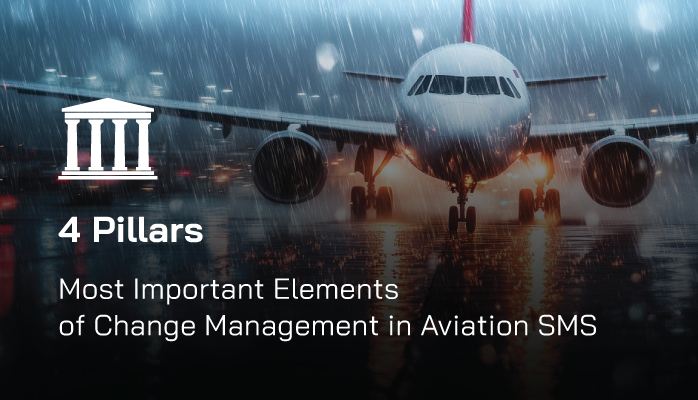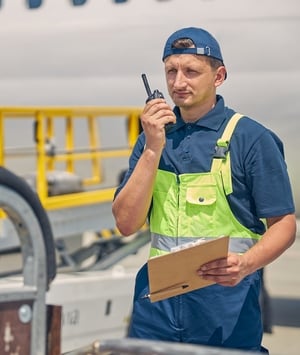What Is Change Management in Aviation SMS

Since November 2006, most commercial aviation service providers have been required to implement formal aviation safety management systems (SMS) to comply with the International Civil Aviation Organization's (ICAO) mandate.
These operators must develop and maintain a formal risk management process for identifying hazards and implementing needed changes in their operational environments to help reduce risk to acceptable levels. These changes usually affect existing services and operations; however, new service offerings or operation types will trigger the need to initiate a change management project.
Related Aviation SMS Management of Change Articles
- What Is Management of Change in Aviation SMS
- What Are Best Practices for Change Management in Aviation SMS
- Understanding Management of Change in Aviation SMS
Management of Change Analyzes Expected Risk of Environmental Changes
Change management should describe these effects and the anticipated risk exposure that results from the change.
Some basic tenants of management of change (MOC) are:
- Operators need to establish processes and perform formal hazard analyses and risk assessments on major operational changes, major organizational changes, and changes in key personnel;
- Safety Case/Risk assessments are aviation safety focused;
- Stakeholders are involved in the MOC process; and
- Previous risk assessments and existing hazards are reviewed for possible side effects.
Management of change is a core part of the Safety Assurance (SA) component of the 4 pillars of SMS. This element is satisfied when safety management uses risk management strategies to proactively assess all major changes in the organization and its operations.
Even though MOC belongs to the Safety Assurance component, a MOC project begins with a safety risk management (SRM) triggering condition. These triggering conditions may result from:
- Ineffective risk controls;
- New routes or destinations;
- Operating environment changes,
- New equipment type, etc.
Why Management of Change Is Important for Risk Management
Change management in aviation SMS implementations is not completely intuitive and may become more complex than one initially expects. In short, a MOC project involves many unknown factors and relies on an organization's ability to collect and analyze disparate types of information to facilitate risk management decision-making processes. It involves assessing and considering both current and hypothetical:
- Environments;
- Scenarios; and
- Hazards.
Change management needs to be performed thoroughly. When all elements of a change are not assessed thoroughly enough, companies expose themselves to:
- New hazards and risks;
- Deterioration of existing risk controls; and
- Lack of preparedness for unforeseen events.
Management of change is also important because it covers inter-related aspects of operating processes, regulatory restrictions, and the aviation SMS, including:
- Regulatory changes;
- New routes, vehicles, or aircraft;
- Organizational restructuring;
- Changes in core safety policies and procedures; and
- Employee or management changes, such as a new Safety Manager, layoffs, and new vendors.
The full list of change management operations is considerably longer. The main takeaway is that SMS implementations and external environments are constantly changing, and change management is how aviation SMS implementations adapt to these ever-changing conditions in the safest manner possible. As you would expect, there is a process.
Related Aviation SMS Management of Change Articles
- Relationship Between Management of Change, SA Process, and SRM Process
- 7 Tips Safety Managers Use to Manage Change in Aviation SMS
- 3 Tips for Effective Management of Change Projects in Aviation SMS
How to Perform Management of Change

The strategy that we recommend above all else is to perform change management through a series of:
- Checklists;
- Risk assessments; and
- Approvals.
This ensures that your aviation SMS' change management process:
- Is a top-down, centralized process that can be delegated;
- Standardizes consistent and repeatable actions;
- Can be managed and controlled;
- Eliminates missed steps; and
- Streamlines the implementation of changes.
With checklists and approvals in hand, the general workflow looks like this – though this can change from organization to organization. If you are familiar with the Safety Risk Management Process, you will recognize this change management process as mirroring the SRM process.
- Document the details of the change, the reasons for the change, and the affected parties;
- Identify known hazards that are relevant to the change;
- Conduct hazard analysis to identify new hazards;
- Review risk controls to identify adequate, inadequate, and non-existing risk controls;
- Identify potential compliance requirements;
- Create a list of action items that are needed to implement change, such as action items for training, purchasing, etc.;
- For each action item, create a list of needed tasks to implement changes with corrective actions and preventative actions (CPAs), thereby completing the action item;
- Predict residual risk, which is the estimated risk after safety requirements are implemented or after all avenues of risk reduction have been explored;
- Implement each CPA; and
- Once implementation is complete, review implementation and monitor.
As said, we highly recommend completing all of the above items with a series of checklists and approvals to ensure that the change management team does not miss the needed steps. Implementation of action items can be things such as:
- Risk mitigation controls;
- Additional aviation SMS training;
- Communicating the change to employees; and
- Creating a clean audit trail.
Related Aviation SMS Management of Change Articles
- How to Be Compliant With ICAO Change Management Requirement
- What Is Change Management in Your Aviation SMS?
- 4 Essential Tips for Management of Change in Aviation SMS
Benefits of Change Management in Aviation SMS
Change management provides some natural benefits to aviation SMS implementations. Enhancing these benefits should be one of the secondary goals of change management operations. When MOC is conducted thoroughly, the following benefits will happen naturally:
- Discover new hazards before they adversely affect operations;
- Further develop the hazard register to assist in risk management activities;
- Examine existing risk controls for inadequacy;
- Update policies and procedures to reduce risk to ALARP;
- Involve employees in risk management operations; and
- Hone risk analysis abilities; and
- Develop a healthy, responsive safety culture.
MOC projects can be valuable for improving struggling safety cultures and involving an entire organization in the aviation risk management process. These improvements will not happen overnight, as there will initially be resistance to the way risk is managed.
Best Practices for Management of Change

Best practices for management of change processes are straightforward. First, you need to know:
- How you are performing the change management project (i.e., what is your process/strategy); and
- Why you are performing it.
On the second point, “why” doesn’t mean identifying how the change will affect the existing SMS. In this case “why you are performing it” means understanding underlying goals of all management of change (MOC) operations. In every MOC, you:
- Are assessing current safety culture;
- Need to gain top-level endorsement;
- Are stating the case for change;
- Are communicating the plan;
- Need to identify threats;
- Will necessarily involve upper management and subject matter experts;
- May require interfacing with external organizations, including the Civil Aviation Authority (CAA); and
- Most importantly, are creating ownership of changes.
The above points are based on ACT’s Change Management Principles. It’s your responsibility to make each item obvious while performing each management of change operation. As part of the MOC process, a best practice for each MOC project is to review safety accountabilities, authorities, and responsibilities affected by the change. Is additional training or safety communication necessary to communicate applied changes to affected parties?
As part of the proactive risk management process, safety teams must validate safety performance after organizational and operational changes have taken place to ensure assumptions remain valid and the change is effective. This is the purpose of monitoring residual risk, which we alluded to above.
Related Aviation Risk Management Articles
- Difference Between Reactive, Predictive and Proactive Risk Management in Aviation SMS
- Difference Between Hazards, Risks & Control Measures in Aviation SMS
- What Is Proactive Hazard Identification and Risk Management in Aviation SMS
Larger Operators Scrutinized Most for Managing Change
Management of change affects larger operators more than smaller service providers. Why is this? For starters, there is more operational activity occurring in the larger operations and these operations inherently have more moving parts to manage. Furthermore, larger operators contract and expand the scope of their operations more frequently than smaller operators.
Another reason that the mid-sized and larger operators should not discount the importance of management of change is that regulatory agencies and standards bodies (such as IATA) practice risk-based oversight. The more risk your operations introduce into the "aviation system," the more scrutiny will be expected.
Final Thoughts on Management of Change in Aviation SMS Implementations
There is no one "right way" to manage an MOC project; however, there are expectations that the MOC be reasonably documented. MOC documentation is best managed using a "template approach" to guide your risk management team. The template approach will provide you with a "process" that is required.
For example, in FAA 14 CFR Part 5, Subpart D Safety Assurance, we will see in subsection 5.71 Safety Performance Monitoring and Measurement:
(a) The certificate holder must develop and maintain processes and systems to acquire data with respect to its operations, products, and services to monitor the safety performance of the organization. These processes and systems must include, at a minimum, the following:
(1) Monitoring of operational processes.
(2) Monitoring of the operational environment to detect changes.
...
(b) The certificate holder must develop and maintain processes that analyze the data acquired through the processes and systems identified under paragraph (a) of this section and any other relevant data with respect to its operations, products, and services. (emphasis added)
Source: Federal Register / Vol. 80, No. 5 / Thursday, January 8, 2015 / Rules and Regulations
If you have ever participated in a MOC project, you will realize that there may be many:
- meetings with affected departments;
- communications between regulatory authorities and external agencies;
- assigned tasks that need to be tracked and documented.
How to Manage Management of Change Projects
Managing the workflows and documenting all the MOC activities becomes challenging for most safety professionals. At the bare minimum, you will want to have a template to use to manage your MOC projects. There are simply too many moving parts to keep track of.
Alternatively, there are low-cost, commercially available SMS databases that come with software modules to manage the MOC projects. These integrated SMS databases save considerable time in reviewing hazards, risks, and risk controls, as well as tracking all of the MOC documentation requirements.
If you are experiencing frustration managing your MOC projects, SMS Pro can help with their integrated Management of Change software module. To see SMS Pro in action, including the Management of Change module, check out these short demo videos. For as little as $300 per month, your company could be using tools to manage all SMS requirements, including your MOC projects.
If you don't have a template already, you will find this template extremely useful:
Last updated March 2025.









